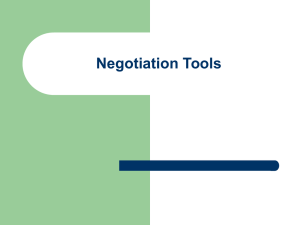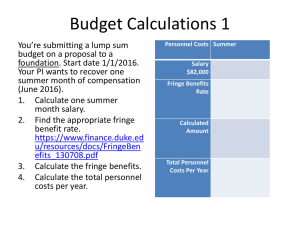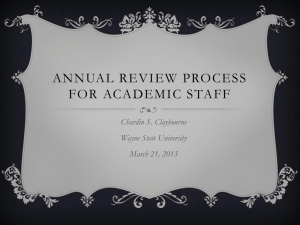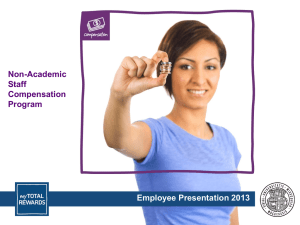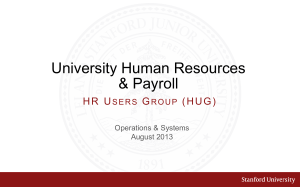Cost Sharing, Personnel Costs, and Effort Commitment
advertisement
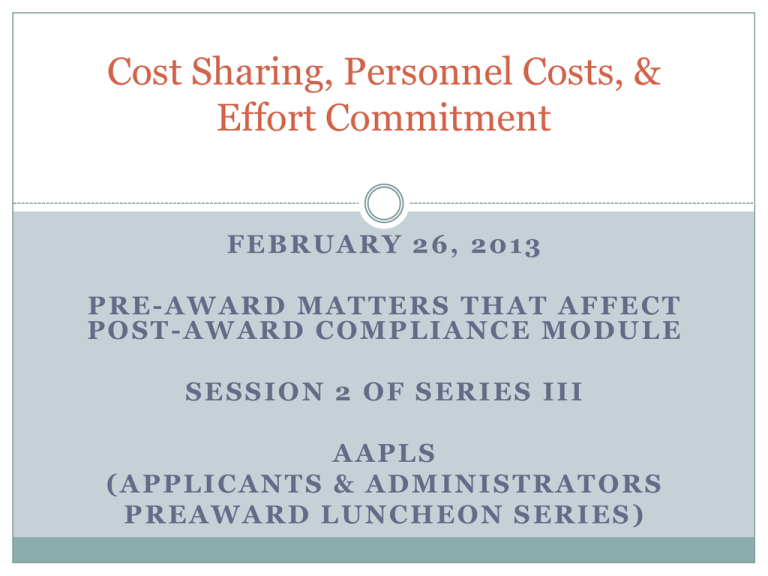
Cost Sharing, Personnel Costs, & Effort Commitment FEBRUARY 26, 2013 PRE-AWARD MATTERS THAT AFFECT POST-AWARD COMPLIANCE MODULE SESSION 2 OF SERIES III AAPLS (APPLICANTS & ADMINISTRATORS PREAWARD LUNCHEON SERIES) Goals of this Session The Connection between pre- and post-award activities. The Partnership needed for grant management: PI, Department Administrator and/or Manager, ORA, and SPA. The Art of managing personnel on grants. The Realities of cost-share and effort commitment. Cost Sharing Occurs when a portion of the cost of a sponsored project is borne by two funding sources. Also referred to as matching and in‐kind contributions. Can be mandated by the sponsoring agency as a condition of award or voluntary by the applicant. In either case, once an award is received in which cost sharing was proposed, the cost share becomes a binding commitment. Only non-federal funds, such as departmental funds and/or unrestricted gifts can be used as cost share. Mandated Cost Share Occurs when the sponsoring agency requests that the applicant institution contribute to the costs of the project. This is specified in the Funding Opportunity Announcement/Request for Application. Examples: One-to-one matching. Fixed amount or a percentage of the costs. Restrictions on salary support and or fringe benefits. NIH Salary Cap Policy NIH Salary Cap Policy Limits the amount of institutional base salary an individual can receive from an NIH-sponsored project. Effective December 23, 2011, the salary cap decreased from $199,700 to $179,700. An investigator’s whose institutional base salary exceeds $179,700 can not allocate the proportion of his/her salary over the cap to the grant. Cost share is equal to the investigator’s percent effort multiplied by the “cap gap,” or the difference between the investigator’s base salary and the salary cap, plus fringe (see handout). NIH Salary Cap Policy, cont. Applies to reduced FTE employees. Salary cap is pro-rated to the employee’s FTE. Cost share is equal to the investigator’s percent effort multiplied by the “cap gap,” or the difference between the investigator’s reduced base salary and the pro-rated salary cap, plus fringe. Example: percent effort = 10% base salary = $200,000 FTE = 0.8 FTE base salary = $160,000 pro-rated cap = $179,700 x 0.8 = $143,760 cap gap = $160,000 - $143,760 = $16,240 cost share = 0.10 x $16,240 + fringe = $1,624 + fringe Voluntary Cost Share Occurs when an individual will not be compensated for his or her effort on a project or other costs are identified as being provided without cost to the sponsoring agency. Example: Dr. Smith will donate/volunteer 2.4 calendar months to the proposed project and will not be compensated for his effort. Dr. Smith will devote 2.0 calendar months to the proposed project, but will only receive 1.2 calendar months of salary support for his effort. Voluntary cost share should be avoided whenever possible. Pre-Award Determine: If there is mandated cost share. If proposed voluntary cost share was intentional. Develop a budget that includes the full cost of the project for internal purposes. Distinguish between the costs requested of the sponsoring agency and the costs being shared by another designated source. Grant application budget pages should only include the costs requested of the sponsoring agency. List $179,700 as the base salary for any investigator whose institutional base salary exceeds the NIH salary cap. Pre-Award, cont. Obtain approval from Dean (or designated official). Identify the cost share on the Internal Sponsored Coordination Form (ISCF), including the type and amount. For some schools, the Dean’s signature on the ISCF serves as his or her approval of the cost share. If the cost share commitment is significant, it will be reviewed by senior management as a fiscal impact on the University could result. Post-Award All cost share must be tracked at the Department level. Cost share related to the NIH Salary Cap Policy should be clearly noted on the investigator’s QER (see handout). Most often reporting is not required for voluntary cost share but if it is included in the application, the sponsoring agency may ask to see the documentation. SPA reviews cost share as outlined in the award notice. If annual or more frequent reporting is required, then it will be reviewed at that time. If cost share reporting is not required or not required until the end of the grant, it will be reviewed when the final financial report is prepared. Personnel Costs Two types: Compensation Signifies an employer/employee relationship. Two components: Salary/institutional base: money an employee receives annually for his or her work. • Funds are requested and allocated based on proposed effort commitment. Fringe benefit rate: employer’s contribution to the cost of an employee’s benefits package. • Rates are set annually by the University. Stipend Living allowance for graduate and doctoral students, and sponsored trainees and fellows. Rate is dictated by the sponsoring agency in accordance with predetermined levels. Traditionally not allowable on research grants with the exception of training grants ( T32, T31, F30, etc). Effort Commitment Expressed as percent effort or person months as dictated by the sponsoring agency. Types of person months (see handout): Academic: 9 month faculty appointment. Summer: 3 month appointment that occurs during the nonacademic months of the calendar year. Calendar: 12 month research appointment. Be clear about method used to calculate effort commitment for reduced FTE employees. Example: 5% of a 0.8 FTE = 4% of a 1.0 FTE (see handout). Changes in Effort Commitment General rule of thumb for all sponsored projects is to: Use the budget prepared as part of your application as your guideline. Check the agency rules, Notice of Award and Funding Opportunity Announcement/Request for Application regarding the need for prior approval. Effort reduction should always be a result of a scientific event, such as: The scientific aim or goal which required the investigator’s effort has been completed. There has been a scientific discovery which requires more effort or a new direction. Scientific events should be mentioned to the Program Officer and Grants Management Specialist either at the time it happens or in the annual progress report. Changes in Effort Commitment, cont. 25% reduction rule for NIH and other federally- sponsored projects. Approval required for changes in effort commitment that represent a 25% or more reduction from what was previously proposed. Approval needed prior to the change in effort. Applicable to PI and Senior/Key Personnel named in the Notice of Grant Award. Be mindful of legacy awards that follow other guidelines. This can be done when completing the annual progress report and answering the eSNAP questions about the upcoming budget period or by contacting the Program Officer and Grants Management Specialist. Extends to the no-cost extension period. Pre-Award Base your personnel budget on the needs of the project, not the budget cap. Consider potential overlaps in effort. Be cautious of who you identify as a Senior/Key Person. Post-Award Use the budget prepared as part of your application as your guideline. Upon receipt of an award, ensure that all necessary actions are taken to appropriately allocate personnel charges to the new award. Generate a Change PAF (including Joint Appointment paperwork) for the anyone working on the grant; do not wait to change effort on the QER. Immediately begin tracking required cost share. Ask for help if you need it. Best Practices for Budgeting Build your budget from the inside out. Use potential start date to project institutional base salary in Year 1. Incorporate a cost of living/merit increase in future years. Use potential start date to determine which fringe rates to use. Incorporate University projected fringe rates in future years as applicable. Consider overlaps in effort. Flag cost share. Closing Thoughts Here’s to a beautiful partnership, managing grants that are both scientifically excellent and fiscally sound!

